Root Canal X-rays Needed for Quality Treatment
Dentists rely on x-rays to properly diagnose dental disease and to correctly treatment plan your root canal. X-rays are an important tool to view important dental tissues that are not directly visible in the mouth. There are a few kinds of x-rays that are very useful during your diagnosis and treatment.
Why Do I Need X-Rays for a Root Canal?
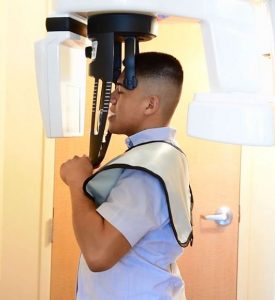 Initially, x-rays help to properly diagnose the need for root canal treatment and assist dentists to visualize
structures that are usually hidden by the gums. Three important structures for a root canal are:
Initially, x-rays help to properly diagnose the need for root canal treatment and assist dentists to visualize
structures that are usually hidden by the gums. Three important structures for a root canal are:
- the root canal space
- the periodontal ligament
- bone surrounding the tooth.
These three structures are impossible to see with the naked eye during your exam. Visualization of these structures enables your dentist to diagnose dental disease and predict the difficulty of your root canal treatment.
During root canal treatment, dentists use x-rays to check their progress and insure the proper placement of the filling material. Progressive x-rays aid your dentist to navigate calcified or narrow canals during difficult cases. Dental insurance companies usually require a final radiograph after treatment completion for reimbursement.
What Types of X-rays do Dentists Use for Root Canals?
There are several types of x-rays that are very useful to dentists. Before treatment, a bitewing and two periapical x-rays at different angles are used to judge the quality of bone and the path of the root canals. During and after treatment, a series of periapical radiographs are used to judge the progress of the procedure and the quality of the root canal filling.
Bitewing X-Ray
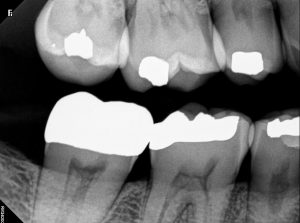
These x-rays are taken by biting down on a special sensor holder that positions the x-ray beam parallel to the tooth. Bitewing x-rays allow the diagnosis of three to four teeth at a time from the top of the tooth crown to halfway down the root. This is the preferred method for examining the bone surrounding the tooth and visualizing the access to the root canal openings.
Periapical X-Ray (PA)
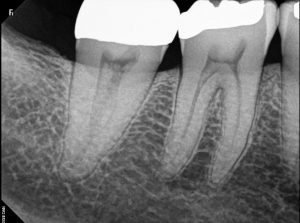
These x-rays use a different sensor holder that positions the x-ray beam to examine one or two teeth from the top of the tooth crown to the tip of the root. This is the preferred method to examine the path of the root canal and the condition of the bone.
Cone beam computed tomography (CBCT)
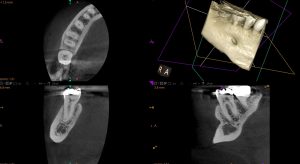
Cone beam computed tomography (CBCT) is a special type of x-ray used when bitewing and periapical x-rays are insufficient. This technology gives a 3-D representation of your soft tissue, bone, teeth and nerve pathways in a single scan. These 3-D images allow your endodontist to better diagnose and understand the true extent of dental disease. CBCT should not be used as a substitute for traditional dental radiographs, but should be used as a supplement when it is expected that the 3-D scan will provide additional information.
Other Useful X-rays
Panoramic X-ray
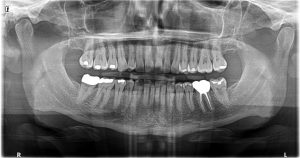 A panoramic x-ray is not usually used for root canal treatment, however, it can be useful for the endodontist to detect
other teeth in your mouth that may benefit from root canal treatment.
A panoramic x-ray is not usually used for root canal treatment, however, it can be useful for the endodontist to detect
other teeth in your mouth that may benefit from root canal treatment.How can I Reduce my Exposure to Radiation from X-rays?
Dentists and patients should take every protection to reduce overall exposure during root canal treatment. It is important that your dentist follows the American Dental Association's recommendations for safe x-ray procedures.
Use a lead apron.
There are many types of lead aprons available during dental treatment. Be sure to use the right type for each exposure. Additionally, many styles of lead aprons have an attached thyroid collar.
Type of film or sensor.
If your dentist uses conventional x-ray film, ask your dentist to use E or F speed film. These films require a lower radiation dose than the slower D speed film. Digital imaging sensors require an even lower radiation dose.
Ask your dentist how an x-ray will help.
If your dentist can explain why an x-ray is medically necessary, don't refuse it. X-rays are medically necessary when the risk of not having a needed x-ray is greater than the small risk from radiation. Additionally, if your dentist explains that an x-ray in unnecessary, don't insist on one.
Inform the dentist if you are, or might be, pregnant.
X-rays are often necessary for pregnant women, however, we take extreme care and protect the fetus from unnecessary exposure. Most importantly, we completely cover your torso with an approved the lead apron. If a single lead apron is not sufficient, an additional lead apron can be used. Before receiving an x-ray, consult your obstetrician.